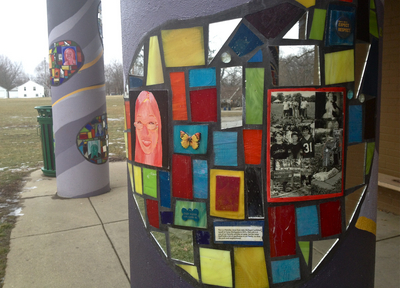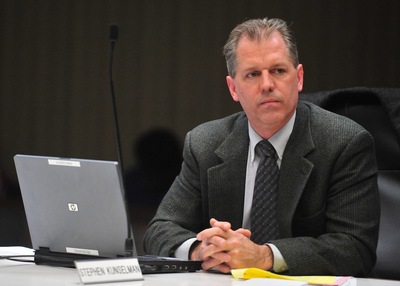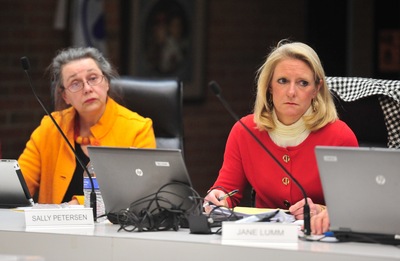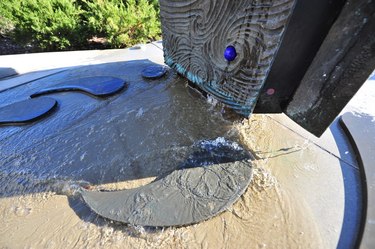Ann Arbor could see sweeping changes to its taxpayer-funded public art program if a task force's recommendations are approved by the City Council.
The city's public art task force has been meeting regularly since its formation in December and it's close to finalizing a set of proposed ordinance changes to take to council.
Among the recommendations coming out of the task force: Hire a full-time public art administrator, establish a new fund for accepting private donations, engage the community more in the selection and funding of art projects, and eliminate the Percent For Art funding mechanism that automatically channels 1 percent of city capital project dollars to a pooled public art fund.

A series of mosaic-style murals on the columns of a shelter at Allmendinger Park was the result of a collaboration between artist Mary Thiefels and members of the community who donated items to be included. It's one of a handful of city-funded public art projects completed under the city's Percent For Art Program, which could be replaced with a new program soon.
Ryan J. Stanton | AnnArbor.com
After that, the changes to the city's controversial Percent for Art Program could end up on the City Council's agenda for first reading March 18, with a public hearing and final reading April 1.
"The issues that we particularly wanted to speak to were those consensus issues that included how and where public art should be placed, what we should use as the funding to pay for public art, and how we could change our public art ordinance in order to allow for temporary art, art that the public selects or the public helps to pay for, and performance art," Briere said.
"We're also working with language that would eliminate the so-called Percent For Art funding mechanism, but would allow capital improvement projects to have public art associated with a project and have it what we call 'baked in' as an ingredient of the project," she said.
Under a Percent For Art ordinance approved by the City Council in 2007, 1 percent of the budget for city capital projects — up to a limit of $250,000 per project — is set aside for public art.
Millions of dollars from various city funds, including the water and sewer utilities and the streets and parks millages, have been channeled into a pooled art fund as a result. The funding mechanism has left the city's Public Art Commission with its hands tied at times — legally able to spend the pooled dollars only on permanent art installations that somehow relate to the source of the funds.
The City Council voted in early December to partially suspend the Percent For Art Program while the five-member task force looked into options for taking a new approach.
The task force's formation came after city voters in November rejected a proposal that would have replaced the Percent For Art Program with a dedicated millage for public art.
The five task force members working out a new solution for public art in Ann Arbor are Briere, Sally Hart Petersen, Stephen Kunselman, Christopher Taylor and Margie Teall.

"They're good recommendations," said Council Member Stephen Kunselman, who has been one of the biggest critics of the city's Percent For Art Program. "They're going to make some good changes in the art program."
Ryan J. Stanton | AnnArbor.com
The task force has determined the pooled Percent For Art funds place a burden on the city's staff to effectively account for each funding stream. It recommends eliminating the pooled funding and removing any reference to a specific percentage of a capital project budget for art.
Instead, the city's staff would have to work to determine whether a specific capital improvement project should have enhanced design features, including either enhanced architectural work or specific public art. And then the funding for such elements would be included in the budget for the project, and that would become part of the request for proposals process for the project.
"The biggest thing for me was making sure we weren't taking money out of our restricted funds and we're going in that direction, so I'm really pleased," Kunselman said.
"It'll be baked into capital projects where council feels it's appropriate. The reality is that's how a lot of percent for art programs actually work. They bake that art into the project itself."
Kunselman said money from restricted funds like the streets millage and the water and sewer utilities still could be used to pay for public art. It just wouldn't be channeled to a pooled fund without a specific project in mind — it would have to be planned up front.
He said the Stadium bridges project is a good example of a project that could have benefited from that approach. Instead of including public art in the project from the start, the city is now trying to figure out how to use $360,000 in pooled art funds for art of some kind on or near the new bridges.
"Rather than having art attached after the fact, art can be a part of the project at the very beginning and that's really important," Kunselman said.

Council Members Sabra Briere, left, and Sally Hart Petersen both serve on the council's public art task force. The task force found there are many successful public art programs around, and the acceptance and enthusiasm for public art grows when the community is involved in the process.
Ryan J. Stanton | AnnArbor.com
The task force is recommending establishing a funding mechanism that allows members of the community to propose and raise funds for specific pieces of art, including projects in public locations with no connection to city capital improvements. Briere mentioned the idea of a bronze Adirondack chair in memory of Coleman Jewett at the Farmers Market as the type of project that could be funded through what the task force is calling an "Art in Public Places Trust Fund."
The city doesn't have a mechanism to accept tax-exempt funds, so the task force recommends working with an organization such as the Ann Arbor Area Community Foundation to establish a fund into which donations for public art can be placed. The task force wants that fund to be able to accept direct donations through one or more "crowdfunding" websites such as Kickstarter.
The task force also found that good public art programs, however they are funded, rely heavily on professional staff.
The city has a part-time public art administrator right now, but the task force argues the city needs a professionally trained public art administrator employed more than 50 percent of the time.
The Percent For Art Program's pooled funds include more than $400,000 of unallocated dollars at the moment. The task force recommends those funds be placed in the proposed Art in Public Places Trust Fund, and that funding for up to two years worth of salary and benefits be paid from the fund for a full-time administrator to help reorganize the program and establish new relationships with the city's staff as needed for any capital improvement projects with artistic elements baked in.
The task force recommends the city's staff review the implementation of any changes in the ordinance after three years. The timing is based on the task force's awareness that capital improvements might take longer than two years to move from inception to completion.

This $750,000 bronze sculpture/fountain in front of Ann Arbor's city hall is considered the signature achievement of the city's Percent For Art Program.
Ryan J. Stanton | AnnArbor.com
Some task force members voiced a concern that if each project that includes enhanced architectural design or public art elements needs to be approved by council, future councils might not honor the consensus position that some public dollars can be used to enhance Ann Arbor's public spaces.
Some also believe the best funding mechanism remains a dedicated millage for public art, and the task force is asking that idea not be permanently shelved.
Teall, a staunch defender of public art, said there are risks as well as gains by going with the approach recommended by the task force, and she considers it a compromise.
"My own focus has been on maintaining not just public funding, but a responsibility that I think we have to help support cultural and artistic endeavors in the city," she said.
"It's my hope that we don't lose out on opportunities for actually publicly funded art," she said, expressing fears that art could be "value-engineered" out of projects by future councils that don't want the city paying for public art. "That's a risk that we're going to have to take, and hope that future councils value art as much as they value parks."
Ryan J. Stanton covers government and politics for AnnArbor.com. Reach him at ryanstanton@annarbor.com or 734-623-2529. You also can follow him on Twitter or subscribe to AnnArbor.com's email newsletters.